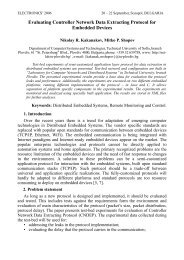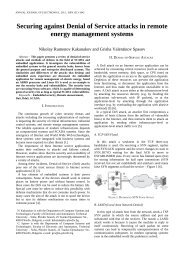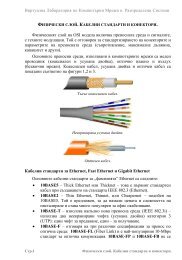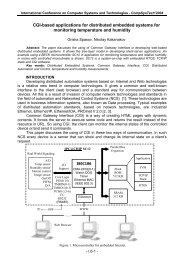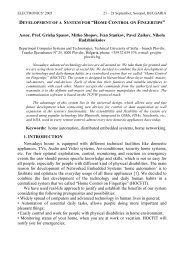SIM300D AT Command Set - Distributed Systems and Networking
SIM300D AT Command Set - Distributed Systems and Networking
SIM300D AT Command Set - Distributed Systems and Networking
You also want an ePaper? Increase the reach of your titles
YUMPU automatically turns print PDFs into web optimized ePapers that Google loves.
<strong>SIM300D</strong> <strong>AT</strong> <strong>Comm<strong>and</strong></strong> <strong>Set</strong><br />
Confidential SIMCOM<br />
Parameters<br />
0 Buffer unsolicited result codes in the TA. If TA result<br />
<strong>SIM300D</strong>_<strong>AT</strong>_V1.00 Page 90 of 180<br />
code buffer is full, indications can be buffered in some<br />
other place or the oldest indications may be discarded<br />
<strong>and</strong> replaced with the new received indications.<br />
1 Discard indication <strong>and</strong> reject new received message<br />
unsolicited result codes when TA-TE link is reserved<br />
(e.g. in on-line data mode). Otherwise forward them<br />
directly to the TE.<br />
2 Buffer unsolicited result codes in the TA when TA-TE<br />
link is reserved (e.g. in on-line data mode) <strong>and</strong> flush<br />
them to the TE after reservation. Otherwise forward<br />
them directly to the TE.<br />
3 Forward unsolicited result codes directly to the TE.<br />
TA-TE link specific inb<strong>and</strong> technique used to embed<br />
result codes <strong>and</strong> data when TA is in on-line data mode.<br />
(the rules for storing received SMs depend on its data coding<br />
scheme (refer GSM 03.38 [2]), preferred memory<br />
storage (+CPMS) setting <strong>and</strong> this value):<br />
0 No SMS-DELIVER indications are routed to the TE.<br />
1 If SMS-DELIVER is stored into ME/TA, indication of<br />
the memory location is routed to the TE using<br />
unsolicited result code: +CMTI: ,<br />
2 SMS-DELIVERs (except class 2) are routed directly to<br />
the TE using unsolicited result code: +CMT:<br />
[], (PDU mode<br />
enabled) or +CMT: , [],<br />
[,,,,,,,] (text mode enabled; about<br />
parameters in italics, refer comm<strong>and</strong> Show Text Mode<br />
Parameters +CSDH). Class 2 messages result in<br />
indication as defined in =1.<br />
3 Class 3 SMS-DELIVERs are routed directly to TE<br />
using unsolicited result codes defined in =2.<br />
Messages of other classes result in indication as<br />
defined in =1.<br />
(the rules for storing received CBMs depend on its data<br />
coding scheme (refer GSM 03.38 [2]), the setting of<br />
Select CBM Types (+CSCB) <strong>and</strong> this value):<br />
0 No CBM indications are routed to the TE.<br />
2 New CBMs are routed directly to the TE using<br />
unsolicited result code: +CBM:<br />
(PDU mode enabled) or



